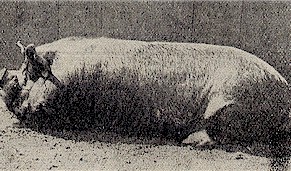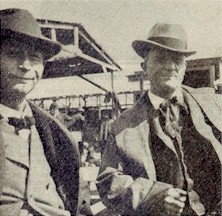
|
Agricultural History Series |
Missouri State University |
1904 St. Louis Worlds Fair
Berkshire Hog Show
Berkshire hogs are black with six white points on their bodies. The breed was characterized by short snouts. Berkshires also have erect ears and a short snout. The Breeder’s Gazette described the Berkshire exhibit at the St. Louis World’s Fair as the greatest of its kind in the world. There were 30 exhibitors and 412 head of Berkshires which outnumbered any other swine breed on the grounds. The St. Louis exhibit was an excellent opportunity for Berkshire breeders from around the world to showcase the wonderful progress that the breed had made. The Breeder’s Gazette stated that the Berkshire breed had fallen out of favor due to its “over-wrought fineness.” However, new breeding practices had allowed the breed to regain ground. It was claimed that only the Large Yorkshires and Tamworth could challenge the Berkshires in size, bone, and weight.
A fancy head and ear.
W. E. Spicer of Bushnell, Illinois judged the Berkshire show. Mr. Spicer had many years of experience as a breeder, exhibitor, and judge. He was very deliberate in his work. However, many exhibitors did not believe that Mr. Spicer lived up to their expectations. More than half of the Berkshire breeders united in a written protest, and requested another judge. Mr. Spicer fell ill prior to judging the final three classes of females and was assisted by T. A. Harris of Lamine, Missouri.
There were two key players throughout this competition, C. I. Hood and N. H. Gentry. Mr. Hood was a millionaire manufacturer from Lowell, Massachusetts. N. H. Gentry was a well-know Berkshire breeder from Sedalia, Missouri. Many people credit Mr. Gentry with having a very large influence on bringing the Berkshire breed back into favor by “effecting changes that were demanded by modern market conditions.” It was noted that Mr. Gentry seemed to have natural instincts for selecting traits that improved the breed. Products of his herd dominated the exhibit in St. Louis. Members of Mr. Gentry's herd won twenty-three first prizes out of a possible twenty-eight. In fact, Mr. Gentry won $2,300 in prize money at the Worlds Fair. This dominance led to the Breeder’s Gazette describing Gentry as a “master breeder.” Every hog that competed in the exhibition was descended from the Gentry strain of animals.

N. H. Gentry with John F. Stover at his right.
The Breeder’s Gazette stated that the aged boar class was the "hardest show for any breed to make." Controversy resulted from the final standings in this class. Premier Longfellow was the winner of the aged boar class. However, many people felt that Masterpiece should have taken home the honor. The Breeder’s Gazette described Masterpiece as the “best boar of the breed that had ever been seen.” As a sire, Premier Longfellow would achieve distinguished honors before the fair was over.
The category for senior yearling boars was a new addition for swine show classifications. The winner of the class was Premier Longfellow 2d. This boar, like the second place finisher Premier Longfellow 3d, was a full brother to Premier Longfellow. Premier Longfellow 3d was viewed by many to have shown “appreciably more scale and depth” than Premier Longfellow 2d.

A prize winning Berkshire hog.
Twenty-eight pigs were entered in the senior boar pig class. The Breeder’s Gazette stated that in the end, a pig of length and size won out. Baron Longfellow 2d was seen as a very impressive boar. Many observers felt that this boar would have been greatly improved if his ham had a little more width and his tail setting were better.
The boar pig class was won by Baron Duke 63d. This was one of the few classes that had a clear cut winner. This boar was also sired by Premier Longfellow. Baron Duke 63d won the class despite not being the largest or the heaviest competitor. The most notable characteristic about this boar was his feet. The rest of the lot was criticized for having poor feet.
The aged sows class was won by another product of N. H. Gentry’s farm. Duchess 254th clearly stood out from the rest of the competition. She was the little sister to Premier Longfellow. She was said to be just a little better sow than he was a boar. Duchess 254th displayed to a high degree all of the characteristics that were common in the products of N.H. Gentry’s herd. She had a long, level, and deep ham.
In describing the remaining sow classes at the St. Louis Worlds Fair, The Breeder’s Gazette stated that “a half-dozen good sows in a class makes a capital show at a state fair, but when a score are driven in, without appreciable let-down in quality, it will stir the pulses of the most seasoned and the most critical campaigner.”
Berkshire First Prize Winners:
Aged Boars- Premier Longfellow; N. H. Gentry, Sedalia, Mo
Senior Yearling Boars- Premier Longfellow 2d, N. H. Gentry; Sedalia, Mo.
Junior Yearling Boars- Baron Premier 3d; N. H. Gentry, Sedalia, Mo.
Senior Boar Pigs- Baron Longfellow 2d; Geo. W. Jessup, Rockville, Ind.
Boar Pigs- Baron Duke 63d; N. H. Gentry, Sedalia, Mo.
Aged Sows- Duchess 254th; N. H. Gentry, Sedalia, Mo.
Senior Yearling Sows- Duchess 279th; N. H. Gentry, Sedalia, Mo.
Junior Yearlings- Hood Farm Holyrood 22d; C.I. Hood, Lowell, Mass.
Senior Sow Pigs- Royal Princess; J. Riley and Son, Thorntown, Ind.
Junior Sow Pigs- Duchess 306th; N. H. Gentry, Sedalia, Mo.
References: The Breeder’s Gazette, October 12, 1904, and Journal of Agriculture, November 17, 1904.
Photos from The Breeder's Gazette, October 12, 1904.
This page was designed by Adam Brock and is maintained by Lyndon Irwin.
Go back to the main hog page.
Go back to the Worlds Fair page.